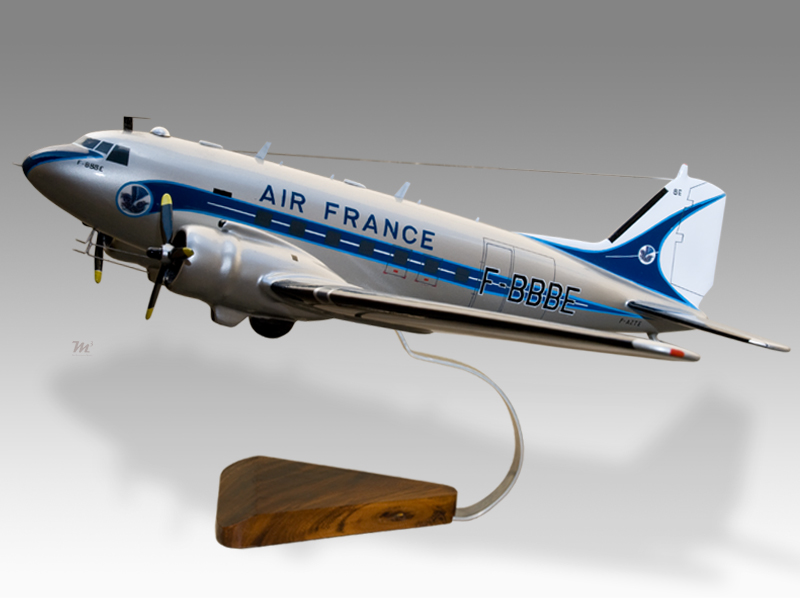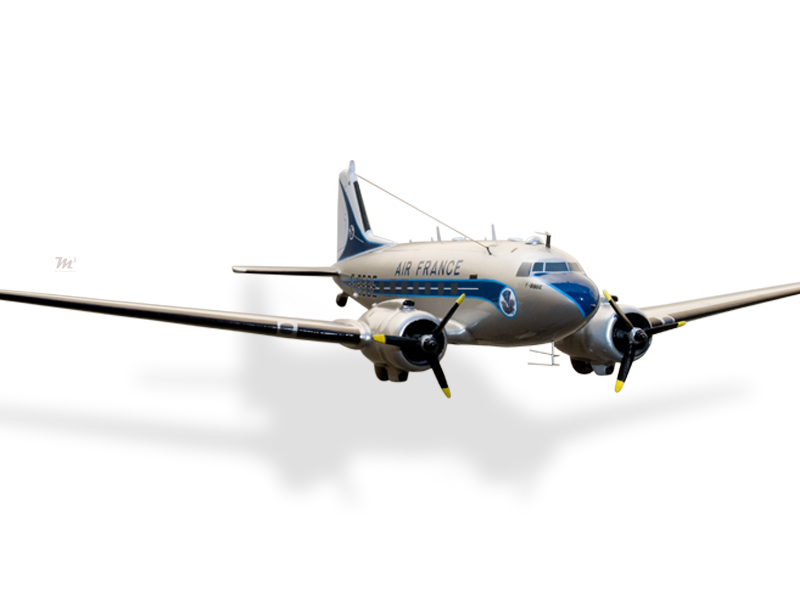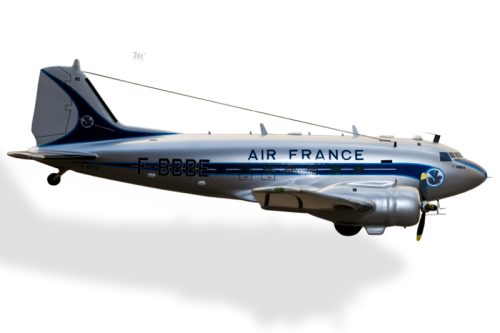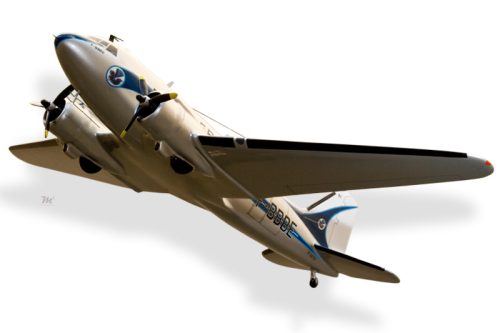Douglas DC-3 C-47 Skytrain Air France Model
Production Time 9 to 10 weeks
Shipment is by FedEx, UPS or DHL International Express Courier with a normal door-to-door delivery time worldwide of within 2-3 business days after dispatch. Due to the current volatility of world fuel prices, the amount mentioned here is our best estimate for DHL and UPS and may be subject to change at the time of shipping.

Product Statistics
Length: 11.5 Inches (29.2 Centimeters)Wingspan: 17 Inches (43.2 Centimeters)
Height: 3 Inches (7.6 Centimeters)
Scale: 1:67
$239.50
Manufacturer: Douglas / Air France
Production Time 9 to 10 weeks
-
United States dollar ($)
-
Pound sterling (£)
-
Euro (€)
-
Australian dollar ($)
-
Canadian dollar ($)
-
Singapore dollar ($)
-
Swiss franc (CHF)
-
Japanese yen (¥)
-
Danish krone (kr.)
-
Hong Kong dollar ($)
-
Norwegian krone (kr)
-
Swedish krona (kr)
General Product Description
Our MyMahoganyModel Douglas DC-3 C-47 Skytrain Air France Model exhibits unique, unrivaled quality and detailed design to come as close as possible to the accuracy of the actual plane. It comes as standard with a robust, durable base or stand which is available in a variety of different finishes designed to match your own personal requirements including solid wood, wood with polished metal supports or adjustable wood wall mount and will be ready within about 9-10 weeks from placement of order.
The Douglas DC-3 C-47 Skytrain Air France Model is made of the finest kiln dried renewable mahogany wood (commonly known as Lauan or Meranti) which has undergone many stages of carving and meticulous and careful sanding giving the beautiful finished museum quality masterpiece. Many collectors and model connoisseurs demonstrate their preference for genuine handmade and hand painted mahogany wood models rather than plastic or die cast (diecast) alternatives due to the overall look and totally different feel of the item - we trust you will find the same. We can, however, if required produce the same model in Solid Cast Resin so just click and contact us us for further information. Our craftsmen and gifted artisans ensure that our finely handcrafted model airplanes match the precise blueprint details of the original aircraft. The paint scheme, markings and parts are closely matched, reflecting the original aircraft. This stylish top-quality desktop replica model will surely enthrall anyone who receives this as a gift and for sure one of the most appropriate and desirably collectable gifts for any aviation enthusiast and avid aircraft collector whilst also displaying a perfect resemblance to the actual aircraft.
If you require we can also make the Douglas DC-3 C-47 Skytrain Air France Model in any other airline, private livery or colour scheme you require and if necessary in a different size or scale. Just click here to contact us with a description or photographs of what you require, and we will let you have a quotation for the necessary customization by return email. We can also make bespoke scale replicas of any other private / civil commercial airliner or airliners, helicopter, glider, gliders with engines, military jet, warplane jets, propeller warplanes, biplane, triplane, tail fin, spacecraft, rocket or NASA model you require in any airline, military or civilian livery or colors. We also produce model airships, blimp, dirigible, blimps, boat and ship collectibles. Wall plaque or seal for military, government or private customers. Again, by clicking here to contact us just let us know exactly what you need.
The ubiquitous Douglas DC-3, what can be said about this aircraft that has not already been said ?
17th December 1935 was a day that made history. It was a day when the first Airliner took its maiden flight and marked the first day that enabled operators to make a profit simply by carrying nothing but passengers from one place to another.
American Airlines were the first to use the DC-3 commercially and on June 25th 1936 the first established profit making route (New York to Chicago) was born.
With the advent of the war lots of orders came pouring in both from the military and from commercial Airliners which had Douglas producing almost 600 DC-3/C-47s a month. Between 1935 and 1947 Douglas had built a total of 10,654 of the type and 63 years later (today) there are still almost a 1,000 in flying condition. What is more, some of these are still workhorses for Airlines and the military in various roles that one would still find hard to believe. Because of its continuing role in aviation and still competing with the modern Jet era, the DC-3 still has no true replacement and one can now assume that it is the most immortal plane of all time.
Today, the DC-3 is still finding its greatest use in specialized roles with some third world military forces and is commercially useful in some back country and bush areas particularly because of its operating costs, its ability to perform from rough fields and with its low maintenance, these are virtues to be considered ahead of the modern designs. So long as the airframes remain strong, (the DC-3 has never been faulted for its structural integrity to this day) there is no reason why this bird will not fly forever. Theres an old saying.. The only replacement for a DC-3 is another DC-3 and as I write this today, I believe this still holds true.
——————————————————————————–
The Douglas DC-3/C-47 Specifications and Variant Information
Role: Military Transport (+C-47+.)/ Early Airliner; Currently Passenger/Cargo Transport
Engines: Two 895-kW Pratt and Whitney R-1830-S1C3G Twin Wasp radials at 1200hp
Performance:
Maximum Cruising Speed: 207 mph
Ceiling: 23,200 Feet
Range with maximum fuel: 2,125 miles
Weight:
Empty: 16,865 lbs
Maximum Takeoff: 25,200 lbs
Dimensions:
Wingspan: 95ft
Length: 64ft 5 frac12;in
Height 16ft 11 frac12;in
Cost:
$138,000
Variants: +DST+.: Original model powered by Wright Cyclone radials that carried 14 night or 28 day passengers
+DST-A+.: Same as DST but powered with Prattamp; Whitney Twin Wasp radials
DC-3: Day transport that carried between 21 and 28 passengers powered by Cyclone radials
+DC-3A+.: Similar to DC-3 but powered with Twin Wasp radials
+DC-3B+.: Convertible model with seat/berths in the forward cabin and seats in the aft cabin for 28 day passengers and few night passengers
+C-41A+.:
The fist military model, a DC-3 with military instrumentation, swivelling seats, and R-1830-21 Twin Wasp radial engines
C-47: First military production model with 6in greater span, revised fuel tanks, R-1830-92 radials, small astrodome, and payload of 6,000lb or 28 paratroops or 14 casualties and three attendants
C-47A: C-47 with 24 volt instead of 12 volt electrical system
RC-47A: Postwar modification for limited reconnaissance and flare-dropping in support of tactical combat aircraft in Korea
+SC-47A+.: Postwar search and rescue variant later redesignated HC-47A
+VC-47A+.: Postwar modification for staff transport with conventional seating
+C-47B+.: Developed for operations over the hump between India and China. This version had better heating and R-1830-90C radials with two-stage blowers. Later converted to +C-47D+.
+TC-47B+.: Navigation trainer
+VC-47B+.: C-47B conversion to staff transport
+XC-47C+.: Experimental model fitted with floats, only one built
+C-47D+.: +C-47B+. after the removal of the high blower
+AC-47D+.: Designation of 26 Airways Check version for Military Air Transport Service later redesignated +EC-47D+.
+RC-47D+.: Reconnaissance version
+SC-47D+.: Search and rescue variant, later redesignated +HC-47D+.
+TC-47D+.: Trainer modification
+C-47E+.: Modified for the USAF by Pan American with 962-kW Prattamp; Whitney R-2000-R radials for use as Airways Check aircraft
+YC-47F+.: Initially designated YC-129, a single Super DC-3 evaluated by the USAF
+C-47M+.: +C-47H+. and +C-47J+. aircraft redesignated after ebing fitted with special electronic equipment for use in the Vietnam War
+EC-47N+.: +C-47A+. fitted for electronic reconnaissance in Vietnam
EC-47P: C-47D fitted for electronic reconnaissance in Vietnam
+EC-47Q+.: Used for electronic reconnaissance in Vietnam fitted with R-2000-4 engines
+C-48+.: A DC-3A taken over from United Air Lines during construction
+C-48A+.: Three DC-3As taken over
+C-48B+.: 16 impressed aircraft
+C-48C+.: Seven DC-3As taken over from Pan American during construction, nine impressed aircraft
+C-49+.: Six DC-3s taken over from TWA
+C-49A+.: One DC-3 taken over from Delta
+C-49B+.: Three DC-3s taken over from Eastern Air Lines
+C-49C+.: Two DC-3s taken over from Delta
+C-49D+.: Six DC-3s taken over from Eastern Air Lines, five impressed aircraft
+C-49E+.: 22 impressed aircraft
+C-49F+.: Nine impressed aircraft
+C-49G+.: Eight impressed aircraft
+C-49H+.: 19 impressed aircraft
+C-49J+.: 34 DC-3s taken over
+C-49K+.: 23 DC-3s taken over
+C-50+.: Four DC-3s taken over from American
+C-50A+.: Two DC-3s taken over from American
C-50B: Three DC-3s taken over from Braniff
+C-50C+.: One DC-3 taken over from Penn Central
+C-50D+.: Four DC-3s taken over from Penn Central
+C-51+.: One DC-3 taken over from Canadian Colonial
+C-52+.: One DC-3A taken over from United
+C-52A+.: One DC-3A taken over from Western
+C-52B+.: Two DC-3As taken over from United
+C-52C+.: One DC-3A taken over from Eastern Air Lines
+C-52D+.: One impressed aircraft
+C-53 Skytrooper+.: A dedicated troop transport with R-1830-92 Radials that had 28 seats, a glider tow, and no freight door
+XC-53A+.: C-53 modified for use in the Arctic with hot air de-icers instead of pneumatic boots
+C-53B+.: Eight C-53s modified for use in the Arctic with winterised equipment and extra fuel capacity
+C-53C+.: 17 airline-ordered impressed aircraft
+C-53D+.: C-53 with side seats instead of seats in rows
+C-68+.: Two impressed DC-3As
+C-84+.: Four impressed aircraft
+C-117A+.: Similar to C-47B, a staff transport with 21 seats
+C-117B+.: 11 C-117As with their high blowers removed for the R-1830-90C radials
+C-117C+.: Designation of VC-47 models upgraded to C-117B
+C-117D+.: Redesignation of R4D-8
+XCG-17+: Experamental troop carrying glider, no production
+R4D-1+.: Freight model for US Navy
+R4D-2+.: Two DC-3s taken over from Eastern Air Lines for staff transport by the US Navy later redesginated R4D-2F and R4D-2Z
+R4D-3+.: 20 C-43 personal transports from USAF
+R4D-4+.: 10 DC-3s taken over from Pan American by the US Navy and used as personell transports, later converted to R4D-4Q and modified for electronic countermeasures
+R4D-5+.: C-47As recieved from USAF and later redesignated C-47H
+R4D-5E+.: R4-D aircraft modified for special electronic operations
+R4D-5L+.: R4D-5 aircraft modified for operations in the Arctic and Antarctic later redesignated LC-47H
+R4D-5Q+.: R4D-5 aircraft modified for radar countermeasures later redesignated EC-47H
+R4D-5R+.: R4D-5 aircraft modified for personnel transports later redesignated TC-47H
+R4D-5S+.: R4D-5 aircraft modified for air-sea warfare training later redesignated SC-47H
+R4D-5T+.: R4D-5 modified for navigation training
+R4D-5Z+.: R4D-5 aircraft modified for staff transports later redesignated VC-47H
+R4D-6+.: 150 C-47B aircraft recieved by the US Navy from the USAF. Later redesignated +C-47J+.. Other versions include: R4D-6E, R4D-6L later LC-47J, R4D-6Q later EC-47J, +.R4D-6R+. later TC-47J, R4D-6s later SC-47J, R4D-6T and R4D-6z later VC-47J
+R4D-7+.: 47 TC-47B aircraft recieved by the US Navy from the USAAD later redesignated +TC-47K+.
+Dakota Mk I+.: RAF equivalent of the C-47
+Dakota Mk II+.: RAF equivalent of the C-53
+Dakota Mk III+.: RAF Equivalent of the C-47A
+Dakota Mk IV+.: RAF equivalent of the C-47B
+Lisunov Li-2+.: Russian licence-built version.
+PS-84+.: First version with M-62 radials
+Li-2G+.: Shvestov ASh-62 radials, armed with turreted armament, freighter version
+Li-2P+.: Same as Li-2G but Personnel transport
+Li-2PG+. Same as Li-2G but convertible model
+Li-2V+.: Same as Li-2G but high altitude model
+Showa L2D+.: A Japanese company, Mitsui, acquired a license to produce the DC-3 in Japan and Manchuria
+L2D2+.: Personnel transports with Kinsei 43 radials
+L2D3+.: Personnel transports with Kinsei 51 radials
+L2D3a+.: Personnel transports with Kinsei 53 radials
L2D3-1: Freighters with Kinsei 51 radials
L2D3-1a: Freighters with Kinsei 53 radials
L2D4: Personnel transports with Kinsei 51 radials and a 13.2mm machine gun in the dorsal turret
L2D4-1: Freighter version of L2D4
L2D5: Personnel transport based on the L3D4 but built out of wood and steel and powered by Kinsei 62 radials
+Super DC-3+.
(+DC-35+.): Improved post-war version originally DC-3S
+R4D+.-8X: Protoype YC-129/YC-47F evaluated for US Navy use
R4D-8: 100 US Navy aircraft modified to Super DC-3 standard. All surviving variants of R4D-8 were designated in the C-117D series
R4D-8T: Modified R4D-8 as a trainer later redesignated TC-117D
R4D-8Z: Modified R4D-8 as staff transport later redesignated VC-117D
R4D-8L: R4D-8 modified for winterised transports later redesignated LC-117D
+Douglas C-32+.
Original XC-32 was a military version of the DC-2 commercial airliner. Differed from the commercial airliner only in minor details and in being powered by 750 hp Wright R-1820-12 radials. Only one built. Designation C-32A given to 24 DC-2 commercial airliners acquired by the Army in 1942 from civilian sources including 5 aircraft previously acquired by the British Purchasing Commission). 14 seats. 210 mph at 8000 ft. 1000 mile range. Most had their original Wright Cyclone SGR-1820-F3 radials, but a couple were fitted with military 740 hp Wright R-1820-33s. Not all were actually taken on strength by USAAF.
+Douglas C-33+.
Military cargo version of DC-2 series. Enlarged vertical tail, reinforced cabin floor, large cargo door. 2400 lbs of cargo or 12 passengers. Two 750 hp Wright R-1820-25 radials. 18 built.
+Douglas C-34+.
Military version of DC-2 commercial airliner. Similar to XC-32 except for minor revisions in interior arrangements. Two built.
+Douglas C-38+.
Military version of DC-2 twin-engine commercial airliner. Had DC-3 outer wing married to a DC-2 fuselage and center section. Prototype of the the series of aircraft sometimes known as DC 2 frac12;. One built. Two Wright R-1820-45 Cyclone radials.
+Douglas C-39+.
Twin-engine military transport. Production version of C-38 aerodynamic prototype. Had DC-3 outer wing married to a DC-2 fuselage and center section. Two 795 hp Wright R-1820-55 Cyclone radials. Used primarily as cargo transport. 35 built. Last aircraft in the DC-2 series to come off the production line.
+Douglas C-41+.
Was a one-off version of C-39 intended as staff transport for Chief of Staff of Army Air Corps. Two 1200 hp Pamp; W R-1830-21 radials. Generally similar to C-39. One built.
+Douglas C-41A+.
Was military version of DC-3A re-equipped with military instruments and communication equipment. Two 1200 hp Pamp; W R-1830-21 radials. Served as staff transport. One built.
+Douglas C-42+.
Staff transport for use by Commanding General of the Air Force GHQ. Similar to C-41 but powered by two 1000 hp Wright R-1820-21 radials. One built.
Douglas C-47 Skytrain
Redesign of civilian DC-3 twin-engine commercial airliner for role of military cargo transport. Large cargo-loading doors, reinforced floor. Astrodome added behind flight deck. Two Pamp; W R-1830-92 radials. 229 mph at 7500 ft. Crew 3. Up to 6000 lbs of cargo could be carried. Most widely used military transport in World War 2. Used by RAF as Dakota, by US Navy as R4D. Puff the Magic Dragon version equipped with three 7.62mm Miniguns and used in Vietnam as heavily-armed gunship.
+Douglas C-48+.
Designation given to 36 DC-3As taken over from the airlines and used by the Army as personnel transports. Two Pamp; W R-1830 radials.
+Douglas C-49+.
Designation given to 138 DC-3s taken over from the airlines and used by the Army as personnel transports. Two Wright R-1820 radials.
+Douglas C-50+.
Designation given to 14 DC-3s taken over from airline orders and used by the Army as personnel transports. Two Wright R-1820 radials.
+Douglas C-51+.
Designation given to a single DC-3 taken over from airline order and used by the Army as paratroop transport. Two Wright R-1820 radials. Crew 3, 28 passengers.
+Douglas C-52+.
Designation given to 6 DC-3s taken over on the production lines before delivery and fitted as paratroop transports. Two Pamp; W R-1830-51 radials. Crew 3, 28 passengers.
+Douglas C-53 Skytrooper+.
Paratroop transport version of C-47. Fixed metal seats, no large cargo door, no reinforced floor, no astrodome. Two Pamp; W R-1830-92 radials. Could carry up to 28 fully-armed paratroops.
+Douglas C-84+.
Designation given to four DC-3Bs taken over from the airlines and used by the Army as personnel transports. Two Wright R-1820-G202 radials.
+Douglas C-110+.
Designation given to three DC-5 twin-engined commercial transports impressed by Army from Australian operators. Two Wright R-1820-G102A radials. 230 mph at 7700 feet. Crew 3, 16-22 passengers.
+Douglas C-117+.
Twin-engine staff transport externally similar to C-47, the military version of the DC-3 commercial airliner. Combination of original features developed for DC-3 with latest improvements developed for C-47. 21-seat airline-type interior. Two Pamp; W R-1830-90C radials. Many released for sale to the airlines after the war. One hundred C-47J airliners reengineered by Douglas by introduction of new wings, a new taller vertical tail, modified landing gear, and more powerful engines and used by US Navy under designation C-117D.
+Douglas YC-129+.
Designation given to a single Super DC-3 ordered by USAF in 1951 for trials. Larger horizontal and vertical tail surfaces with squared tips. New outer wing panels with squared tips. Smoother engine nacelles with doors that fully enclosed the retracted wheels. Powered by two Wright R-1820-C9HE radials, 1475 hp. 270 mph. Later redesignated YC-47F. USAF decided not to order the YC-47F and transferred the aircraft to US Navy which designated it R4D-8X. Subsequently, the Navy modified 100 earlier R4Ds to R4D-8 configuration
| Weight | 6 kg |
|---|---|
| Dimensions | 11.5 × 17 × 3 in |











Reviews
There are no reviews yet.